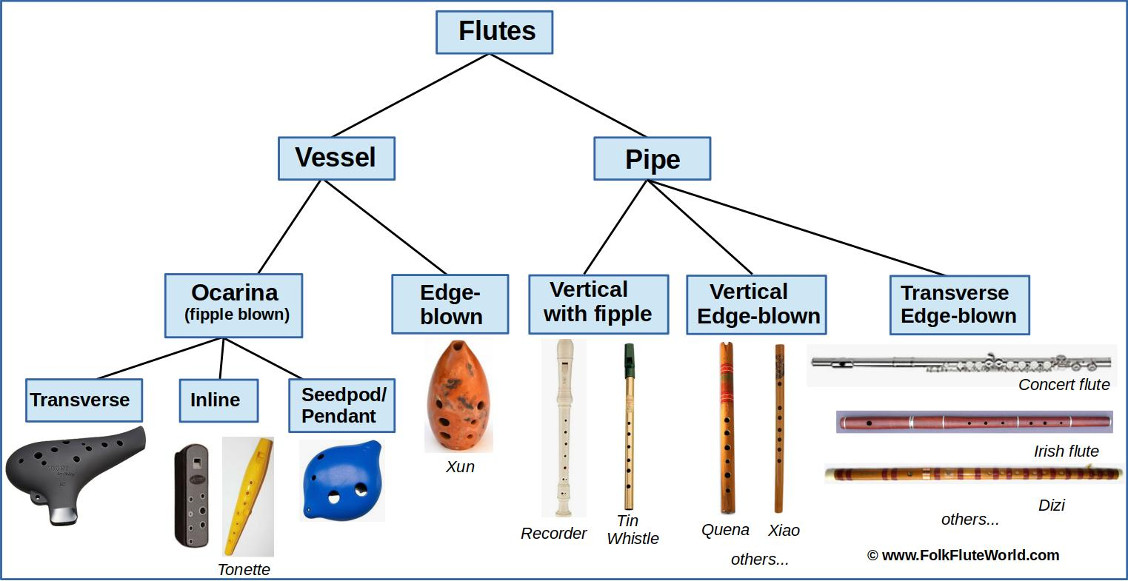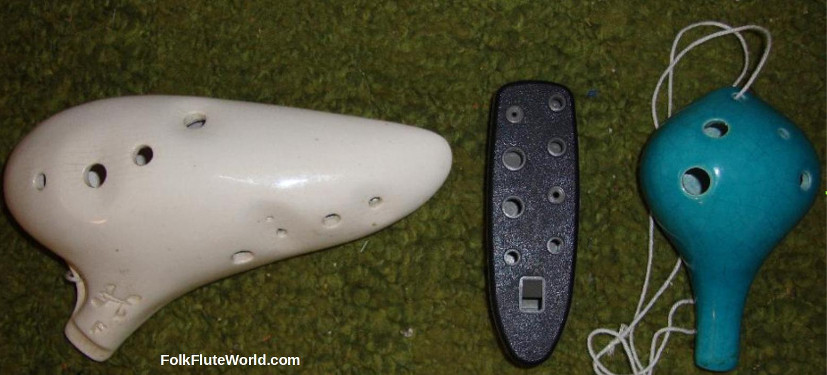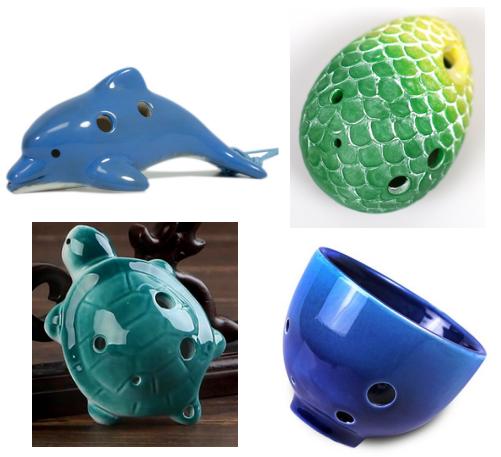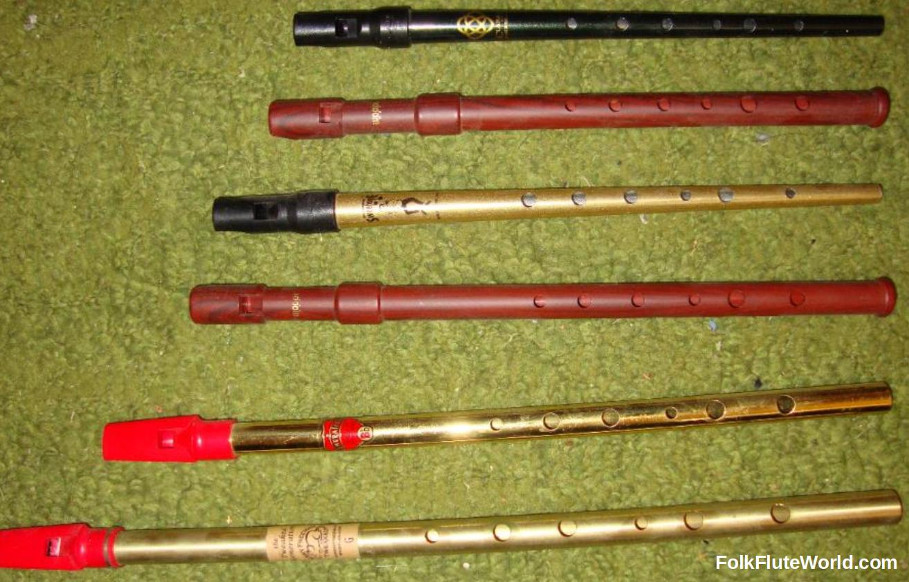by Howard Fosdick © FolkFluteWorld.com.
This website covers "folk flutes." So what are they?
A folk flute is any flute that lacks mechanical keys.
A flute is a type of woodwind instrument that creates sound waves by splitting the player's breath upon a sharp edge. This contrasts with woodwinds that create sound by vibrating a reed (such as clarinets, saxophones, and oboes).
So, flutes are woodwinds that produce sound in the same way you do when you blow across the lip of a pop bottle. Folk flutes are flutes that lack keys.
The Flute Family
At first blush, you might not think the flute family is particularly large. We're all aware of metal concert flutes, and perhaps other flutes we've seen, such as recorders or ocarinas, or maybe wood flutes or pennywhistles.
But dig a little deeper, and you'll realize that the flute family is huge. Nearly every culture has developed its own regional flute varieties. Look up "Chinese Flutes" in Wikipedia, for example, and you'll find that China alone has spawned about two dozen distinctive kinds of flutes! Now imagine how many flutes all the cultures of the world have developed over the 40,000 years or so since the first one.
Most of those varieties are folk flutes. Why? Well, the push towards mechanized woodwind instruments was really a phenomenon of the 19th century. In fact, the modern concert flute and its relatives only reached full fruition by the mid-1800s.
In contrast, keyless folk flutes are the natural, indigenous developments of human cultures around the globe. Their tools and means of creation are orders of magnitude easier than the manufacture of mechanized metal flutes. All ancient man had to do was carve a hole or two into a bone, or close up a clay pot to create a "pop bottle" flute, or whittle a stick to suit.
Topology
Given such wide variety of flutes, how can we make sense of them all?
We've already mentioned one distinction, that between the simple manual flutes we call folk flutes, and the modern flutes that feature keys to extend their capabilities.
What other distinctions are there?
Take a look at this chart:

How to Classify Flutes
One vital distinction is between vessel flutes and pipe flutes. Vessel flutes -- sometimes called globular flutes -- are enclosed chambers inside of which air vibrates, or resonates. Modern ocarinas work like this.
In constrast, pipe flutes are open-ended tubes with fingering holes. Concert flutes and recorders are examples. While vessel flutes produce sound waves that resonate within their enclosed chamber, pipe flutes produce a column of air that vibrates along their tubing.
Another key distinction among flutes is how they spilt the musician's breath to create sound waves. With edge-blown flutes, the player himself must direct his breath appropriately. You do this when you voice a note by blowing across the edge of a pop bottle. You only produce the sound if you hold your mouth at the proper angle to the bottle opening.
In contrast, other flutes come complete with fipples. The fipple is a mouthpiece that automatically directs the player's breath against the sharp edge, called a labium. This produces the sound waves. (Some prefer to call these duct flutes, referring to the passageway or duct that directs the player's breath to the labium.)
This diagram illustrates this distinction. On the left is a side view of a recorder fipple. The air intake automatically directs the player's breath to where it needs to go.
To the right, we see how a musician playing a concert flute must accurately direct his breath himself to create sound. If he positions his mouth at the wrong angle, he doesn't produce a sound.

As you might guess, fipple flutes are much easier to get started with than edge-blown flutes. You can pick up a recorder or ocarina or tin whistle and start sounding notes in no time. It's different with an edge-blown flute. The beginning concert flutist spends weeks to attain the skill to sound all the notes in the scale accurately. This is one reason schoolchildren all start with recorders instead of edge-blown transverse flutes.
By transverse flutes, we mean flutes you hold at a right angle to play, like a traditional concert flute. Other flutes are end-blown, meaning you hold them straight out from your body when you play them, like a recorder. These are also referred to as vertical flutes, since you hold them vertically while playing.
Transverse flutes are nearly always edge-blown. Vertical flutes come in either edge- or fipple- blown varieties.
One final distinction among flutes is worth noting. A diatonic instrument only plays whole notes. It doesn't play sharps or flats.
A chromatic instrument plays all whole notes within its range, also all the sharps and flats between them. To relate this idea to a piano, a diatonic instrument plays only the notes of the white keys, while a fully chromatic one plays the black keys as well.
This distinction is important because some folk flutes are so primitive that they are diatonic. Others are more musically capable and are fully chromatic. (And then there are those that are in-between: they play sharps and flats but only if you are highly skilled.)
Vessel Flutes
Let's talk about vessel flutes. They originated in antiquity as untuned whistles. Usually they were made of baked clay, just like pottery. Here are a few examples:

These examples date from 100 BCE to 1,300 AD. They played just a few random sounds, and no two are alike. They weren't tuned like modern instruments.
Ocarinas
In the 1850s, a 17-year-old Italian brickmaker named Giuseppe Donati encountered a vessel flute. He was inspired to modernize it, standardize its shape, and synchronize it to the musical scale. This was the birth of the modern ocarina. An ocarina is a duct- or fipple- based vessel flute.
Today's ocarinas can be classified into three shapes. The photo belows illustrates.
Giuseppe Donati's invention is on the left. It's called a transverse ocarina because it extends sideways from your mouth when you play it. Some call it a sweet potato or submarine. The "oc" in the middle is an inline that sticks straight out from your mouth when you play it. The rightmost oc is a seedpod. Seedpods are often called pendants because small ones can be worn on a necklace.

Modern Ocarinas: Transverse, Inline, and Seedpod
With modern ingenuity, it's not surprising that ocarinas have morphed into all sorts of fun shapes. This photo shows a dolphin, a dragon's egg, a turtle, and a tea cup. These are all fully capable musical instruments. (You can both drink tea from and play the tea cup!)

These Fun Ocs Are All Playable (Photo by H. Fosdick)
But beware... not every cute little vessel flute is a modern musical instrument. The ancient tradition of vessel flutes with special shapes that only play a few sounds continues into the present day. You can spot these by the fact that all their holes are the same size. A true musical instrument requires different-sized holes.
You can read more about the development of the ocarina in my article
here,
or read
this comparison
of ocarinas to tin whistles, recorders, and Native American flutes.
Pipe Flutes
Like vessel flutes, tubular flutes date back into antiquity. One can readily envision early man tooting a note or two through a hollowed bone or reed. This naturally evolved into more sophisticated flutes with finger holes and fipples, and then finally mechanical keys.
A hollow wood stick without a single finger hole can produce a range of sounds. The musician blows softer or harder into the tube to produce notes in what is called the harmonic series. So even without fingering holes a skilled musician can produce a range of notes by blowing into an unadorned tube. It all depends on his breath pressure.
This earliest flute is still a proud part of many cultural traditions today. In Scandinavia, it's called the willow flute; in Russia and Ukraine, it's the kalyuka; and in Slovakia, it's the koncovka.
Generically, these are all called overtone flutes. You can read all about them in my companion article here.

Playing End-Blown and Transverse Overtone Flutes
(Photos courtesy of Shemyaz at Youtube and OvertoneFlute.fi)
From primitive overtone flutes, dozens of different kinds of pipe flutes evolved amongst the world's varied cultures.
Among them are a large family of edge-blown tranverse flutes. Examples include the Chinese dizi, the Japanese ryūteki and shinobue, the Indian bansuri, and the Vietnamese sáo.
Some vertical flutes lack fipples and are edge-blown. This family includes the Chinese xiao, the Japanese shakuhachi, the quena flute from the Andes, and many more.
Other vertical flutes come complete with fipples. These have become predominant in western cultures. Probably this is because the fipple is an invention that makes these flutes easier to play.
Let's take a quick look at three of the most popular in this category: the recorder, the tin whistle, and the Native American flute.
Recorders
The recorder took form during the middle ages. It features a full two-octave range, and it's fairly simple to finger the notes. Plus it's a fipple flute, so breath control is not much of a challenge compared to edge-blown folk flutes. Recorders have soft, mellifluous voices yet can adapt to any musical style.
Some folks dislike the recorder because they were forced to learn it in grade or middle school. But truly, it's an amazingly versatile little instrument. This photo shows how modern recorders come in all sizes and pitches:

Recorders, from the Bass Down to the Sopranino (Photo courtesy of TurnerSCO.com)
Tin Whistles
Another modern flute that is even easier to get started with than the recorder is the tin whistle.
Also called the pennywhistle or the English flageolet, tin whistles assumed their modern form in the 1840s. A poor farm labourer named Richard Clarke heard about the invention of tin plate and asked a metal smith to form it into a whistle like his wood-carved one. The result was the modern tin whistle -- still called that today, even though most are now made from other metal alloys, woods, and plastics.
With a fipple and only six holes, tin whistles make for simple yet versatile musical instruments. They offer a full two-octave range, nearly as much as recorders. But whereas one partially covers the octave key to attain high recorder notes, one just blows the tin whistle harder to sound the high notes. This is called overblowing. It's the same principle that powers the overtone flute.
Like recorders, whistles come in a full range of sizes and pitches, and nearly every imaginable key:

Tin Whistles of All Sizes, Pitches, and Materials (Photo by H. Fosdick)
Native American Flutes
Finally, we mention the Native American flute. Indigenous Americans developed many kinds of flutes, but perhaps the most popular style features an external block held in place by a strap:

Native American Flutes (Photo from Frank B. on Pinterest)
The Native American flute-making tradition stretches back centuries. By the 1980s, most makers standardized their flutes on a minor pentatonic scale. This included common fingerings for many 5- and 6- hole varieties. This standardization led to an explosion of interest in Native American flutes. It also makes them easily playable by those with little musical background. You can't literally hit a wrong note in the pentatonic scale, because all the notes sound harmonious together.
Native American flutes hold special appeal because the traditional emphasis is on meditation and personal growth, rather than playing for audiences. For many, this instrument becomes a very personalized form of musical expression.
About This Website
So there you have it, a whirlwind introduction to the fluting universe. This website concentrates on fipple folk flutes because many are easy to learn and simple to play. That's one reason ocarinas, recorders, tin whistles, and Native American flutes are so popular.
Another is that these versatile little instruments can adapt to any musical style you prefer. And, played to their potential, they can sound ethereal or haunting. They prove flutes don't require keys or complexity to attain exquisite sound.
Many folk flutes are lightweight and portable. I'd rather take my plastic recorder or a tin whistle to the beach or on a camping trip than risk a thousand-dollar concert flute to the vagaries of travel and the elements.
And, folk flutes offer a compelling cost advantage. For most of us, the $30 recorder or ocarina or a $15 tin whistle is all we need to enjoy ourselves.
For the price of a dinner, you can buy a folk flute that will keep you entertained for years. For the price of one concert instrument, you can build an entire collection. Even the financially constrained can enjoy a range of folk flutes and all the variety they offer.
This website's goal is to direct you to everything you need to succeed, all of it for free. It points you to the best free tutorials and lessons, and links to websites offering free sheet music for thousands of songs. We'll give you the advice you need to start, and the links you'll need to become more proficient.
It's all about free resources for your personal exploration. We concentrate on the most popular folk flutes: ocarinas, tin whistles, recorders, Native American Flutes, and the little plastic flutes you may remember playing in middle school. But any flute that catches our interest is fair game. After all, this is a hobbyist website. (100% ad-free and non-commercial.)
If this article has you wondering whether to take up the ocarina, recorder, tin whistle, or Native American flute, you might find this comparison useful.
Meanwhile, I hope you enjoy your musical journey as much as I have mine.
-------------------------------------
